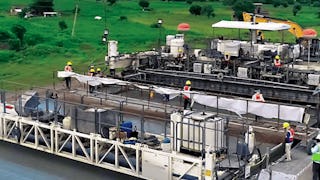The "Geometric and Traffic Aspects of Highway" course introduces Indian highway development and classification, covering highway alignment, cross-sectional elements, supporting facilities, and pavement layers. Learners will gain insights into the geometric design of highways, focusing on safety, driver comfort, and operational efficiency. Key topics include sight distance for road safety, horizontal alignment elements such as superelevation and transition curves, and vertical alignment considerations, including gradients and curve types like summit and valley curves. The course will also explore highway drainage, including catchment analysis, discharge calculations, and hydraulic drain design. Traffic engineering will be covered, starting with principles, characteristics, volume surveys, and studies on parking and accidents, followed by data analysis and road capacity planning. Additionally, learners will examine traffic control devices, including signs, signals, pavement markings, junctions, interchanges, rotaries, and road furniture. By the end of the course, learners will have essential knowledge in highway geometric planning, drainage, traffic engineering, and control devices. Target learners include civil engineering graduate and post-graduate students, as well as professionals in transportation and infrastructure development, with prerequisites in Concrete Technology, Geotechnical Engineering, Building Materials & Construction, and Construction Equipment & Methods.



Geometric and Traffic Aspects of Highway
This course is part of Highway Planning, Pavement Design and Construction Specialization

Instructor: Subject Matter Expert
Access provided by Coursera Learning Team
Recommended experience
Details to know

Add to your LinkedIn profile
5 assignments
March 2025
See how employees at top companies are mastering in-demand skills

Build your subject-matter expertise
- Learn new concepts from industry experts
- Gain a foundational understanding of a subject or tool
- Develop job-relevant skills with hands-on projects
- Earn a shareable career certificate


Earn a career certificate
Add this credential to your LinkedIn profile, resume, or CV
Share it on social media and in your performance review

There are 5 modules in this course
In this module, "Overview of Indian Highway System," learners will explore the historical evolution and classification principles of Indian highways, emphasizing the importance of well-established networks. The module covers distinguishing road types, analyzing road network patterns, and exploring factors influencing classification. It focuses on highway alignment, cross-sectional elements, road furniture, traffic control devices, and supporting facilities.
What's included
8 videos2 readings1 assignment1 discussion prompt6 plugins
In this module, "Geometric Standards of Highway Design," learners will acquire knowledge about the geometric design of highways, focusing on ensuring safety, driver comfort, and operational efficiency. The module covers critical concepts such as sight distance for optimal road safety and extends to horizontal alignment elements like superelevation and transition curves. Additionally, it provides insights into vertical alignment, including gradients and distinctive curve types like summit and valley curves.
What's included
1 assignment1 discussion prompt5 plugins
In this module, "Highway Drainage," learners will develop a comprehensive understanding of highway drainage systems, hydrological analysis, and discharge calculations. The module covers the components of highway drainage systems, their importance, and common issues. Key topics include various types of drains, catchment analysis, and catchment delineation. Learners will also acquire skills in discharge calculations using different formulas and gain insight into software tools for effective hydrological and hydraulic modeling.
What's included
1 assignment1 discussion prompt6 plugins
In this module, “Traffic Engineering,” offers a comprehensive overview of traffic engineering fundamentals, including traffic characteristics, volume count surveys, origin and destination studies, and pedestrian counts. It also examines traffic speed studies, miscellaneous traffic surveys, parking assessments, and accident analyses. Emphasis is placed on analyzing and interpreting survey data to estimate design traffic and plan road capacity effectively. Additionally, the module covers evaluating the level of service and applying these insights to optimize traffic flow and road usage.
What's included
1 assignment1 discussion prompt13 plugins
In this module, "Traffic Control Devices," learners will explore essential traffic control and road safety elements, including traffic signs, signals, and signal design. It covers pavement markings, road furniture, junctions, interchanges, and traffic rotaries. Additionally, the module addresses temporary traffic control measures and wayside amenities to enhance driver comfort and safety. The module provides a holistic understanding of traffic control mechanisms and their real-world applications.
What's included
1 assignment1 discussion prompt11 plugins
Instructor

Offered by
Why people choose Coursera for their career




Recommended if you're interested in Physical Science and Engineering

L&T EduTech

L&T EduTech

Open new doors with Coursera Plus
Unlimited access to 10,000+ world-class courses, hands-on projects, and job-ready certificate programs - all included in your subscription
Advance your career with an online degree
Earn a degree from world-class universities - 100% online
Join over 3,400 global companies that choose Coursera for Business
Upskill your employees to excel in the digital economy




